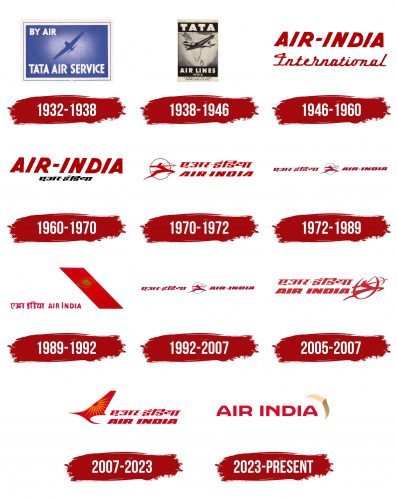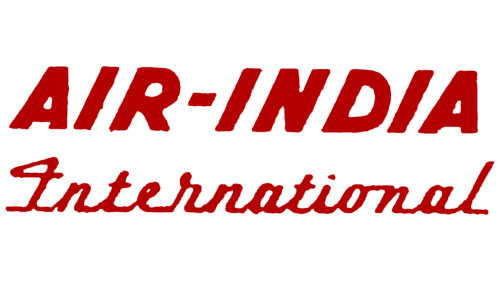The Air India logo is a vivid symbol that represents the airline’s long history and its connection to India’s cultural heritage. It visually embodies the national carrier’s goal to strengthen links between India and the rest of the world through international and domestic flights. The logo emphasizes Air India’s role as a messenger of Indian hospitality and cultural diversity, conveying the idea of connecting various parts of the world with India.
Air India: Brand overview
Tata Air Services was established on October 15, 1932, when Air India began to exist. J.R.D. Tata, a well-known Indian industrialist and aviation pioneer, founded the business. Initially, the airline ran mail flights between Karachi and Bombay or Mumbai. This was a risky move, considering how little commercial aviation existed in India then.
The business started offering scheduled passenger flights after changing its name to Tata Airlines in 1938. This was a significant milestone in the growth of India’s civil aviation industry, creating new avenues for tourism and business travel.
The company became a public business in 1946 and changed its name to Air India following the end of World War II. This move reflected the company’s expanding goals and desire to become India’s national carrier.
The company’s first international flight, which took out from Bombay to London via Cairo and Geneva in 1948, signaled the start of its global carrier expansion and its foray onto the worldwide scene.
It was nationalized in 1953 when the Indian government purchased 49% of the company’s stock. This was part of a larger plan to give the government more control over important economic areas.
After obtaining Boeing 707 aircraft, the airline began additional long-haul routes, including flights to the United States, throughout the 1960s, greatly expanding its fleet and route network.
It expanded during the 1970s and 1980s by launching new routes and purchasing additional aircraft. The business gained recognition as one of the top airlines in the world, renowned for its excellent service and warm Indian welcome.
With the liberalization of the Indian economy in the 1990s, commercial airlines began to pose a greater threat to the company. It was compelled to modernize and adapt to keep its place in the market.
The Indian government combined the company with Indian Airlines, a domestic carrier, in 2007. This merger aimed to build a more powerful and competitive national airline.
The airline experienced severe financial difficulties in the 2010s due to intense competition, growing expenses, and ineffective management. The Indian government helped the corporation restructure in several ways, including providing financial support and making efforts to streamline operations.
The Indian government declared its intention to privatize the company in 2018. However, the first attempt failed because possible bidders weren’t interested.
The government continued its efforts to privatize the airline in 2019 and 2020, changing the conditions of the sale to entice investors.
Meaning and History
What is Air India?
Air India, the national airline of India, was established in 1932 and is wholly owned by the government. It is one of Asia’s oldest and leading airlines, offering a wide range of regular and charter flights in India and internationally. The central office of Air India is located in New Delhi, and the airline is a member of the Star Alliance. With a fleet of over 100 aircraft, Air India serves more than 60 international and 100 domestic routes. Additionally, the company provides catering services, cargo transport, and professional pilot training.
1932 – 1938
From 1932 to 1938, Air India’s logo was based on a postage stamp, which suited its primary role of airmail delivery. The design was chosen to represent the airline’s first items: letters and parcels. The stamp-like logo showed the company’s link to airmail services and its contribution to aviation delivery in India.
The logo featured a blue background representing the sky, fitting for an airline. In the center, an airplane silhouette moved forward and upward, symbolizing aspiration and progress and highlighting Air India’s focus on flight services.
At the bottom, the airline’s name appeared in beige letters. These letters honored Jehangir Ratanji Dadabhoy Tata, the airline’s founder and an important Indian industrialist and aviator. The font and color of the letters matched the overall design while paying tribute to the founder. The logo was appealing and reflected the company’s objectives well.
1938 – 1946
In 1938, Air India revamped its logo to resemble a poster, aiming to promote its services and highlight the growing opportunities in intercontinental air travel. The logo featured a yellowish paper banner that stood out as a real advertisement, easily noticeable on any building wall.
The design prominently depicted continents, especially Africa and India, where Air India operated. This illustrated the airline’s focus on connecting these regions to the rest of the world. A realistic image of a flying airplane at the logo’s center added a sense of motion, emphasizing Air India’s role in air transport.
The top of the image displayed the company’s headquarters address, making contact information easily accessible, while the bottom noted the airline’s affiliation with Tata Sons. This association underscored Air India’s stability and connection to a respected business group.
1946 – 1960
In 1946, Air India changed its name to mark a new phase in its growth. Two years later, when the Government of India bought the airline and made it the national carrier, the logo was redesigned. This change symbolized Air India’s expansion and its rising international presence.
With the acquisition of international flight permissions, the word “International” was added to the airline’s name, reflecting its global ambitions and goal to be a major player in international aviation. The logo featured a red, bold inscription that made it more eye-catching and represented Air India’s new opportunities and growth.
With a slight forward tilt, the new logo conveyed dynamism and assertiveness, showing Air India’s commitment to continuous progress, innovation, and expanding its flight destinations. This rebranding also increased company revenues, emphasizing its leading position in the market.
1960 – 1970
In 1960, Air India’s logo was redesigned to include an inscription in Hindi, reflecting the airline’s commitment to India’s cultural heritage and strengthening national identity. This addition aimed to show respect for the language revered in Indian history and to enhance the airline’s connection with its domestic passengers.
The logo featured English and Hindi, representing Air India’s global reach and local dedication. This bilingual approach highlighted its role in connecting diverse cultures and continents.
Black in the Hindi script represents equality and unity among India’s diverse ethnic groups. This color also helps distinguish charter flights in Air India’s broad service range. The black logo adds visual impact and underscores the airline’s comprehensive offerings, including regular and charter flights.
1970 – 1972
In the 1970s, the Air India logo was redesigned to showcase innovation and creativity, featuring bold new elements like the Sun and a leaping centaur. This unique design differentiated it from typical aviation symbols and added intrigue, highlighting the company’s fresh approach to branding. This change was part of Air India’s plan to promote its new services and reflect broader changes in its operations.
Air India also moved its headquarters to the outskirts of Bombay, expanding its services. The company established a charter flight subsidiary and launched a network of airport hotels under the Centaur brand, diversifying its business into hospitality and strengthening its reputation as an innovative airline.
The updated logo featured a solar disk with a centaur at the center, symbolizing transformation and blending aviation and hospitality. The centaur is depicted pulling back a bowstring, and the forward-pointing arrow symbolizes strength, speed, and the pursuit of new goals.
Additionally, the logo included an inscription in Hindi, highlighting Air India’s dedication to the Indian market and its commitment to local passengers. This element underlined the airline’s deep connection to its cultural roots even as it expanded globally.
1972 – 1989
In 1972, Air India updated its visual style, notably changing the size and color of its emblem. The new burgundy color, associated with nobility and luxury, is intended to boost the airline’s image by positioning its aircraft as transport with luxurious comfort facilities.
The logo was redesigned to be more elongated, aligning elements in a single line for a sleeker, more elegant look. The image of a centaur drawing a bow between Hindi and English inscriptions symbolized the blend of Eastern and Western cultures. This design emphasized Air India’s international routes from India to Europe and underscored the brand’s uniqueness.
The central solar disk in the logo served a dual purpose. It resembled the side of an airplane, similar to a window offering views of the clouds and sun. Additionally, the inscriptions on the sides were reminiscent of wings, giving the entire design an airplane-like appearance. This style caught the eye and reflected Air India’s focus on aviation.
1989 – 1992
In 1989, Air India enhanced its brand by adding an image of the Sun to the tails of its airplanes. The Sun symbolizes life, energy, and continual movement, representing the airline’s peak of development and success in the aviation industry. This new emblem marked Air India’s transformation, embodying its ambitions and drive for new heights. It also aimed to differentiate the airline in customer service with a unique and memorable image.
Despite these intentions and the symbol’s deep meaning, the new design received mixed reactions from passengers. Some customers debated the change and did not favor the innovation, leading to the emblem’s brief duration despite its visual appeal and symbolic depth.
1992 – 2007
In 1992, Air India decided to revert to its 1972 logo. This choice was based on a thorough analysis, emphasizing the importance of staying connected to its roots and the elements that had long contributed to its recognition and strength. This strategic move was aimed at maintaining the airline’s established identity.
2005 – 2007
On the eve of its merger with Indian Airlines in the early 2000s, Air India updated its logo to signal a new growth phase and future goals. Following mixed feedback on the previous logo change featuring a golden sun, the company’s marketing team opted for a more conservative update, reverting to the familiar 1970 design.
Air India’s name in this refreshed logo appeared in English and Hindi across two levels, mirroring the earlier design. This choice underscored the multicultural, bilingual fabric of Indian society and reaffirmed Air India’s dedication to its cultural roots while maintaining its role as the leading national airline.
A notable adjustment in the logo was moving the centaur image from the left to the right, adding a sense of movement and future orientation. This symbolized Air India’s ongoing innovation and leadership aspirations in aviation. The centaur now faced forward, reflecting the company’s optimism and readiness for new challenges.
Additionally, the sun disk in the logo was redesigned as a bold open line, suggesting a sharp turn, highlighting the airline’s adaptability and readiness to navigate the rapidly changing aviation industry. The enlarged centaur portrayed a stronger, more potent figure, representing Air India’s confidence and capability to surpass expectations.
2007 – 2023
Air India is one of India’s premier air carriers, and its logo strongly reflects the country’s cultural heritage. The company’s logo consists of a flying swan, which symbolizes the ease and elegance of flight, and the Konark wheel inside it, which reflects the past and future, as well as the chakra symbol, which is a sign of spiritual strength and unity, and the inscription “Air India” in Latin and Hindi alphabets.
The flying swan symbolizes the lightness and grace of flight, freedom, and independence. The Konark wheel inside the swan symbolizes Indian culture and represents the wheel of time, the solar symbol. The chakra below the swan is an important symbol in Indian culture and represents the wheel of life.
Thus, the Air India logo reflects India’s important cultural values, such as freedom, independence, ease and grace of flying, and respect for the country’s history and traditions. These values are ideal for an airline that provides its passengers with a fast, safe, and comfortable flight anywhere in the world.
2023 – today
Air India recently updated its visual identity with a new logo with bold red letters, which are easy to spot and suggest movement and professionalism. The logo uses red to symbolize energy, passion, and strength, fitting for Air India as a vibrant and dependable airline. Additionally, the logo includes a unique design in the top right corner, resembling a bird with outstretched wings. This design connects to a mythological figure from the airline’s past logos, maintaining a link to its history while symbolizing a desire to reach new heights and explore new possibilities.
The logo incorporates a gold accent, adding a touch of luxury and high quality. Gold is associated with nobility and prosperity, underscoring Air India’s commitment to providing top-tier services. The gold detail ties in with themes of the Sun, suggesting warmth, light, and the vast opportunities available to Air India’s passengers.
Font and Colors
The Air India logo features bold italic lettering, giving it a dynamic and modern look. The font is sans-serif, meaning it lacks serifs at the end of characters, resembling Loft Extra Bold Italic with thick, assertive lines.
The font is uniform in size, enhancing readability and recognition. The tight kerning between the letters creates a compact and unified appearance, which helps establish a strong and confident brand image.
The logo’s color scheme combines shades of red and orange. The red font represents passion, energy, and strength, highlighting the airline’s power and global presence. A golden element to the right adds elegance and luxury, reflecting India’s cultural heritage.
A visual element positioned at an angle adds movement and direction, aligning with flight and travel. The bright colors of the font make the Air India logo easily recognizable and memorable, emphasizing the airline’s unique identity on an international level.
FAQ
What is the symbol of Air India?
Air India’s new logo, ‘The Vista,’ marks a fresh step in the airline’s brand. This logo draws inspiration from the top of a golden window frame, suggesting endless opportunities and a forward-thinking approach. The peak design in the logo also represents Air India’s goals to grow and bring new ideas to the aviation world.
The Vista also includes elements from the chakra in Air India’s old logo, a symbol of movement and energy, now styled modernly. Keeping this part of the old logo shows Air India values its history while embracing the future, mixing old traditions with new ideas. The design of the new logo portrays confidence and ambition, setting Air India up as a forward-thinking airline prepared to face upcoming challenges and opportunities.
What is the centaur logo of Air India?
Air India’s first logo, introduced in 1948, featured a centaur, a mythical creature half human, half horse. This centaur, styled as Sagittarius, was shown shooting an arrow within a circle representing the wheel of Konark. Konark is known for its historic Sun Temple and intricate stone carvings of chariot wheels.
J. R. D. Tata, the founder of Air India, selected the logo. It stood for speed, precision, and the ability to travel far, showing the airline’s goal to effectively connect India with the world. The Centaur was the symbol of Air India for nearly 60 years until it changed in 2007. Even though it’s no longer in use, this logo is still a key part of Air India’s history, capturing the early spirit of Indian aviation and its rich cultural roots.
What is the brand revamp of Air India?
In August 2023, Air India launched a new brand identity with a logo called ‘The Vista.’ This logo represents limitless possibilities and a progressive outlook, marking a major update in the airline’s brand approach. ‘The Vista’ symbolizes a forward-thinking and dynamic style, positioning Air India as a modern and innovative force in the global aviation market.
The brand refresh includes a new color palette with Air India red, aubergine, rose gold, and gold accents. These colors give the brand a modern and sophisticated look, making it more appealing and recognizable. The overhaul features custom iconography and a new typeface called Air India Sans, which helps set the brand apart in a competitive market. These elements are designed to be modern and recognizable, adding to the brand’s overall elegance and coherence. This complete brand update shows Air India’s goal to keep up with global trends and lead with innovation.
Who is the CEO of Air India?
Campbell Wilson became the CEO and Managing Director of Air India in June 2022. He started his career in the aviation industry in 1996 at Singapore Airlines in Auckland and worked his way up to vice president of the airline’s operations in Canada by 2006.
Wilson’s experience, especially his long stint at Singapore Airlines, prepared him well to lead Air India during a key period of transformation and growth. Under his leadership, Air India focuses on improving its services, expanding its network, and boosting operational efficiencies. His efforts are part of Air India’s goal to enhance its position and reputation in the global aviation market.
Who designed the Air India logo?
Tasneem Ali designed Air India’s new logo. The logo combines Indian traditions with a modern style and is part of Air India’s efforts to look modern while staying connected to its Indian roots.
The logo’s design considers colors, shapes, and symbols. It reimagines traditional Indian designs in a simple and modern way. This makes the logo adaptable and effective on different platforms. The phrase “Design comes with our heritage” indicates that the logo symbolizes India’s national identity and cultural pride. The new logo aims to attract both international and local travelers. It presents Air India as a representative of Indian hospitality and diversity.















